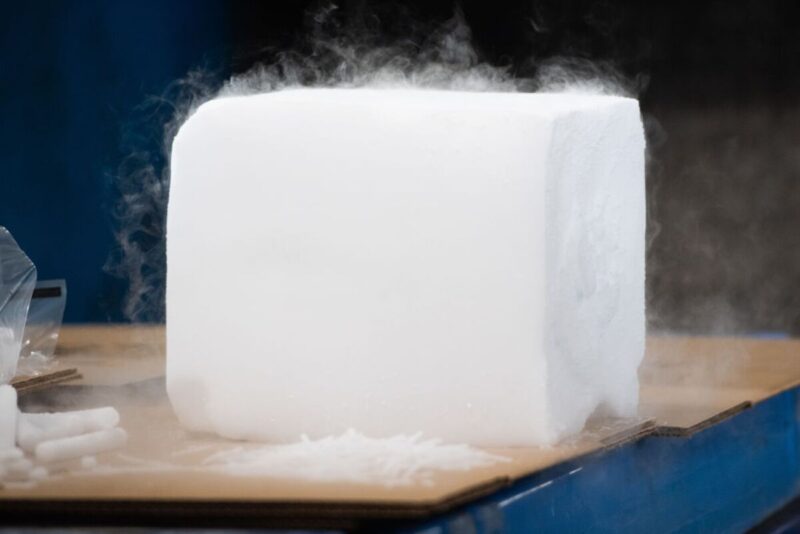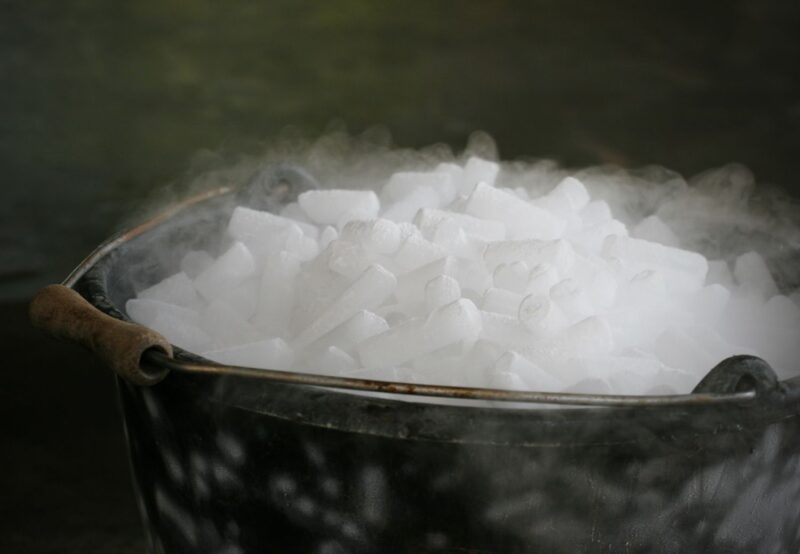Dry ice is a captivating substance that captures our imagination with its unique properties. Composed of frozen carbon dioxide, it is unlike any other form of ice we encounter.
In this comprehensive guide, we will delve into the world of dry ice, exploring its science, shelf life, storage, and diverse applications. By the end, you’ll have a firm understanding of how long dry ice lasts and how to make the most of it in various scenarios.
The Science It
To truly appreciate dry ice, let’s start with its composition. It is solid carbon dioxide, which transforms directly from a solid state to a gas through a process called sublimation. Unlike ordinary ice that melts into a liquid, dry ice bypasses the liquid stage, turning into carbon dioxide gas when exposed to room temperature. This unique property makes it an exceptional cooling agent and creates the mesmerizing fog-like effect.
Several factors influence the sublimation rate, including temperature, packaging, and surface area. The colder the surrounding environment, the slower the sublimation process. Efficiently packaging in insulated containers and reducing its exposure to warm air can also extend its lifespan.
Shelf Life of Dry Ice

Dry ice has a relatively short shelf life compared to regular ice. On average, it lasts between 24 to 48 hours, depending on various factors. The primary factor affecting the shelf life is temperature. In warmer conditions, it sublimates at a faster rate, shortening its lifespan.
To maximize longevity, it is essential to store it properly. Keep it in a well-insulated cooler or an insulated container to minimize exposure to warmer temperatures. Avoid using airtight containers, as the buildup of carbon dioxide gas can cause pressure to build up.
Storage and Handling
When it comes to storing and handling dry ice, safety should be a top priority. It is extremely cold, reaching temperatures as low as -78.5 degrees Celsius (-109.3 degrees Fahrenheit). To protect your skin from frostbite, always wear gloves or use tongs when handling it.
Ventilation is crucial when storing dry ice. Since it sublimates into carbon dioxide gas, it’s essential to keep the area well-ventilated to prevent an excessive buildup of gas. Avoid storing in a confined space, such as a sealed container or a small room, to prevent a potentially dangerous situation.
Improper storage or mishandling can lead to accidents, such as burns, frostbite, or asphyxiation. Always follow safety guidelines and exercise caution when dealing with this powerful cooling agent.
Extending Its Lifespan
Insulating dry ice by wrapping it in newspaper or using an additional layer of insulation, such as Styrofoam, can slow down the sublimation process. This method is particularly useful when transporting perishable items or during longer events where extended cooling is necessary.
Creative storage ideas can also help prolong the lifespan. Utilizing coolers or insulated containers can provide an extra layer of protection against warmer temperatures. These solutions are invaluable for camping trips, picnics, or any situation where you need to keep items chilled for an extended period.
Another scenario where extending the lifespan is crucial is during shipping or transportation. When sending perishable goods or medical supplies that require a cold environment, properly insulated packaging can help maintain the desired temperature and ensure the products arrive in optimal condition.
Using Dry Ice for Special Occasions

Dry ice isn’t just for scientific experiments or industrial applications—it can also add a touch of magic to special occasions. Whether you’re hosting a Halloween party, creating a theatrical effect, or simply want to impress your guests, incorporating it can elevate the ambiance and create an unforgettable experience.
One popular application is creating a spooky fog effect. By placing dry ice in warm water, the sublimation process produces a dense fog that can transform any space into a mysterious setting. However, it’s essential to exercise caution and follow safety guidelines to ensure proper ventilation and prevent direct contact with the skin.
It can also be used to chill beverages and create a visually stunning display. Placing dry ice in a container filled with water and then adding your favorite beverages can give them an icy, smoky appearance. Remember to use gloves or tongs when handling it to avoid any accidents.
Disposal of Dry Ice
Once dry ice has served its purpose, proper disposal is crucial. Unlike regular ice that melts away, it sublimates into gas, requiring specific disposal methods to ensure safety.
The recommended method is to allow it to sublimate in a well-ventilated area. Place it in a container or open space and let it evaporate naturally. Avoid disposing in sinks, toilets, or other enclosed spaces, as the rapid sublimation can cause pressure buildup.
During the disposal process, it’s important to take safety precautions. Always wear gloves or use tongs when handling it to protect your skin from frostbite. Additionally, ensure proper ventilation in the disposal area to prevent the accumulation of carbon dioxide gas.
For those concerned about the environmental impact, there are environmentally friendly options for disposing. Some companies and organizations specialize in dry ice recycling, where they collect and reuse it for various purposes.
Commercial and Industrial Uses
Dry ice finds extensive applications across various industries. In the food industry, it is commonly used for flash freezing, preserving food during transportation, and creating stunning visual effects in culinary presentations. Dry ice blasting, a cleaning method that uses dry ice pellets to remove contaminants, is widely employed in industrial settings, including manufacturing and automotive industries.
The pharmaceutical and medical fields also rely on it for transportation and preservation of temperature-sensitive medications, vaccines, and biological samples. Its ability to maintain a consistently low temperature makes it an invaluable tool in these industries.
Conclusion
Dry ice is a fascinating substance with unique properties that captivate our imagination. Understanding how long it lasts and how to handle it properly is essential for safe and effective usage. From its science and shelf life to storage tips and various applications, we have covered everything you need to know about it.
Embrace the versatility of dry ice and explore the exciting possibilities it offers. With the knowledge gained from this guide, you can confidently harness the power of it while ensuring safety and efficiency in your endeavors. So go ahead, chill out, and unleash the magic of dry ice in your next adventure!
Frequently Asked Questions
Let’s address some common questions that often arise regarding the lifespan of dry ice:
Q: Does dry ice evaporate?
A: It doesn’t evaporate in the traditional sense like water. Instead, it undergoes sublimation, transitioning directly from a solid to a gas state.
Q: Can it go bad?
A: Dry ice doesn’t go bad, but its effectiveness diminishes over time as it sublimates. It is important to use it within its shelf life for optimal results.
Q: Can I store it in my freezer?
A: Storing in a typical household freezer is not recommended. The extremely cold temperature can disrupt the operation of the freezer and potentially damage it. Instead, use a well-insulated cooler or designated storage container.
Q: Can I touch dry ice with my bare hands?
A: It is not safe to touch it with bare hands. Solid carbon dioxide is extremely cold and can cause frostbite or burns. Always use protective gloves or tongs when handling it to prevent injuries.
Q: How do I transport it safely?
A: When transporting, ensure proper insulation and ventilation. Use an insulated cooler or container and keep the area well-ventilated to prevent the buildup of carbon dioxide gas. Follow safety guidelines to protect yourself and others during transportation.
For further research and additional information, consider exploring reliable sources such as scientific publications, government websites, or industry-specific resources.

